Role of Winter Weather Conditions and Slipperiness on Tourists’ Accidents in Finland
Abstract
:1. Introduction
1.1. Health and Well-Being in the North
1.2. The Risk of Injury
1.3. Slippery Conditions
1.4. Aim
2. Materials and Methods
2.1. The Study Population
2.2. Questionnaires and Interviews of Health and Safety Personnel
2.3. Workshops
2.4. Weather-Related Data and Slippery Conditions
2.5. Data Analysis
3. Results
3.1. Seasonal Distribution of Injury Cases
3.2. Non-Local Patients and Extremity Injuries
3.3. Exposure to Slipping Hazards
4. Discussion
- The background characteristics of tourists are important. Some of them may be familiar with snowy and icy conditions but often these tourists are coming from places where they rarely, if ever, encounter snow and ice and they will be unfamiliar and unprepared to face the Nordic winter environment.
- Most of the responders mentioned that the number of tourists has increased significantly even though some of them also noted that the so-called slope culture had improved and therefore the emergency room is not as busy as before during the “Russian week” or skiing holiday weeks.
- According to the responses, the typical traveller/patient has usually hurt him/herself on a slope or has a flu, today’s travellers were also mentioned as being busier than before, and occasionally travellers were already sick when leaving home, which may contribute to the increasing number of injuries.
- There are now more elderly tourists and people with multiple health problems, in particular elderly women with osteoporosis may be at risk when surface conditions are slippery.
- Other factors such as alcohol consumption during special events like New Year’s Eve may increase the number of patients arriving at the emergency room.
- The quality of some municipal services such as keeping the roads clear of snow and ice has an important role.
- Adaptation to environmental changes will be essential in the future [38].
- The future climate predictions. The scenarios provided by the Finnish Meteorological Institute indicate that there will be more warming (in a range of 3–9 °C) and increased precipitations (by 10%–40%) in the winter than in summer (where temperatures are predicted to rise by 1–5 °C and precipitation to increase by 0%–20%) and these winter changes will have a greater impact in the north of the country [48]. These predictions suggest that there will be more freezing point days (with daily minimum temperature below zero and maximum temperature above zero) and therefore the number of frost and thaw cycles will increase in the future meaning that the occurrence of slippery conditions, especially rain on icy surface (scenario 4), will be more common.
- The possible concentration of tourists during certain periods due to the possible shortening of winter season in the future. This will directly affect the management of health care services.
- The ageing of the population. The respondents expect that there will be an increase in the number of older and more frail tourist patients who will need health care during their holiday trip. On the other hand, the fluctuations in wintery weather conditions may deter older people from moving outside [49].
5. Conclusions
Acknowledgments
Author Contributions
Conflicts of Interest
References
- ACIA. Arctic Climate Impact Assessment Scientific Report; Cambridge University Press: Cambridge, UK, 2005. [Google Scholar]
- Rautio, A.; Poppel, B.; Young, K. Human health and well-being. In Arctic Human Development Report. Regional Processes and Global Linkages; Nymand Larsen, J., Fondahl, G., Eds.; Nordisk Ministerråd: Copenhagen, Denmark, 2014; pp. 297–346. [Google Scholar]
- AMAP. AMAP Assessment 2009: Human Health in the Arctic; AMAP: Oslo, Norway, 2009. [Google Scholar]
- Parkinson, A.J.; Evengård, B. Climate change and health in the Arctic. In Climate Change and Global Health; Butler, C.D., Ed.; CABI: Wallingford, UK, 2014; pp. 206–217. [Google Scholar]
- Luoto, T.; Heikkinen, H.I.; Rautio, A. Globalizing challenges of well-being in the Finnish North. Nord. Geogr. Publ. 2014, 43, 45–57. [Google Scholar]
- Pacyna, J.M.; Cousins, I.M.; Halsall, C.; Rautio, A.; Pawlak, J.; Pacyna, E.G.; Sundseth, K.; Wilson, S.; Munthe, J. Impacts on human health in the Arctic owing to climate-induced changes in contaminant cycling—The EU ArcRisk project policy outcome. Environ. Sci. Policy 2015, 50, 200–213. [Google Scholar] [CrossRef]
- Norlander, A.; Miller, M.; Gard, G. Perceived risks for slipping and falling at work during wintertime and criteria for a slip-resistant winter shoe among Swedish outdoor workers. Saf. Sci. 2015, 73, 52–61. [Google Scholar] [CrossRef]
- Gao, C.; Abeysekera, J. Slips and falls on ice and snow in relation to experience in winter climate and winter sport. Saf. Sci. 2004, 42, 537–545. [Google Scholar] [CrossRef]
- Berggård, G. The risk of slipping and falling as pedestrian during wintertime. In Proceedings of the 20th International Conference on Port and Ocean Engineering under Arctic Conditions, Luleå, Sweden, 9–12 June 2009.
- Vuoriainen, T.; Helenius, M.; Heikkilä, J.; Olkkonen, S. Incidence of Falls by Pedestrians and Cyclists in Espoo, Helsinki, Jyväskylä and Oulu. Finnra Reports 48/2000; Finnra, Road and Traffic Technology: Helsinki, Finland, 2000. (In Finnish) [Google Scholar]
- Aschan, C.; Hirvonen, M.; Rajamäki, E.; Mannelin, T. Assessing slip resistance of wintery walkways with a novel portable slipmeter. In Walk 21-V Cities for People, Proceedings of the Fifth International Conference on Walking in the 21st Century, Copenhagen, Denmark, 9–11 June 2004.
- Ruotsalainen, J.; Ruuhela, R.; Kangas, M. Preventing pedestrian slipping accidents with help of weather and pavement condition model. In Walk 21-V Cities for People, Proceedings of the Fifth International Conference on Walking in the 21st Century, Copenhagen, Denmark, 9–11 June 2004.
- Campbell, A.; Spears, G.; Borrie, M.; Fitzgerald, J. Falls, elderly women and the cold. Gerontology 1988, 34, 205–208. [Google Scholar] [CrossRef] [PubMed]
- Lau, E.; Gillespie, B.; Vanti, L.; O’Connell, D. The seasonality of hip fracture and its relationship with weather conditions in New South Wales. Aust. J. Public Health 1995, 19, 76–79. [Google Scholar] [CrossRef] [PubMed]
- Luukinen, H.; Koski, K.; Kivelä, S.L. The relationship between outdoor temperature and the frequency of falls among the elderly in Finland. J. Epidemiol. Commun. Health 1996, 50, 107. [Google Scholar] [CrossRef]
- Parker, M.; Martin, S. Falls, hip fractures and the weather. Eur. J. Epidemiol. 1994, 10, 441–442. [Google Scholar] [CrossRef] [PubMed]
- Flinkkilä, T.; Sirniö, K.; Hippi, M.; Hartonen, S.; Ruuhela, R.; Ohtonen, P.; Hyvönen, P.; Leppilahti, J. Epidemiology and seasonal variation of distal radius fractures in Oulu, Finland. Osteoroposis Int. 2011, 22, 2307–2312. [Google Scholar] [CrossRef] [PubMed]
- Hagel, B.; Goulet, C.; Platt, R.; Pless, I. Injuries among skiers and snowboarders in Quebec. Epidemiology 2004, 15, 279–286. [Google Scholar] [CrossRef] [PubMed]
- Matter-Walstra, K.; Widmer, M.; Busato, A. Seasonal variation in orthopedic health services utilization in Switzerland: The impact of winter sport tourism. BMC Health Serv. Res. 2006. [Google Scholar] [CrossRef] [PubMed] [Green Version]
- Bouter, L.; Knipschild, P.; Volovics, A. Personal and environmental factors in relation to injury risk in downhill skiing. Int. J. Sports Med. 1989, 10, 298–301. [Google Scholar] [CrossRef] [PubMed]
- Schneider, T. Snow skiing injuries. Aust. Fam. Phys. 2003, 32, 499–502. [Google Scholar]
- Koehle, M.S.; Lloyd-Smith, R.; Taunton, J.E. Alpine ski injuries and their prevention. Sports Med. 2002, 32, 785–793. [Google Scholar] [CrossRef] [PubMed]
- Federiuk, C.S.; Mann, N.C. Telemark skiing injuries: Characteristics and risk factors. Wild Environ. Med. 1999, 10, 233–241. [Google Scholar] [CrossRef]
- Dauphiné, A. Risks and Disasters. Observe, Spatialise, Understand, Manage; Armand Colin: Paris, France, 2001. (In French) [Google Scholar]
- Grönqvist, R.; Chang, W.R.; Courtney, T.K.; Leamon, T.B.; Redfern, M.S.; Strandberg, L. Measurement of slipperiness: Fundamental concepts and definitions. Ergonomics 2001, 44, 1102–1117. [Google Scholar] [CrossRef] [PubMed]
- Rouhiainen, V. The Quality Assessment of Safety Analysis; Technical Research Centre of Finland: Espoo, Finland, 1990. [Google Scholar]
- Alwang, J.; Siegel, P.B.; Jørgensen, S.L. Vulnerability: A View from Different Disciplines; Social Protection Discussion Papers; The World Bank: Washington, DC, USA, 2001; Volume 115, pp. 1–42. [Google Scholar]
- Adger, W.N. Vulnerability. Glob. Environ. Chang. 2006, 16, 268–281. [Google Scholar] [CrossRef]
- Bankoff, G.; Frerks, G.; Hilhorst, D. Mapping Vulnerability: Disasters, Development, and People; Earthscan: London, UK, 2004. [Google Scholar]
- Cutter, S. Vulnerability to environmental hazards. Prog. Hum. Geogr. 1996, 20, 529–539. [Google Scholar] [CrossRef]
- Cutter, S.; Boruff, B.; Shirley, L. Social vulnerability to environmental hazards. Soc. Sci. Quart. 2003, 84, 242–261. [Google Scholar] [CrossRef]
- Downing, T.E.; Butterfield, R.; Cohen, S.; Huq, S.; Moss, R.; Rahman, A.; Sokona, Y.; Stephen, L. Climate Change Vulnerability: Linking Impacts and Adaptation. Report to the Governing Council of the United Nations Programme; United Nations Environmental Programme: Nairobi, Kenya, 2001. [Google Scholar]
- Füssel, H.M. Vulnerability: A generally applicable conceptual framework for climate change research. Glob. Environ. Chang. 2007, 17, 155–167. [Google Scholar] [CrossRef]
- Parry, M.L.; Canziani, O.F.; Palutikof, J.P.; Van der Linden, P.J.; Hanson, C.E. Climate Change 2007: Impacts, Adaptation and Vulnerability. Contribution of Working Group II to the Fourth Assessment Report of the Intergovernmental Panel on Climate Change; Cambridge University Press: Cambridge, UK, 2007. [Google Scholar]
- Hagberg, M.; Christiani, D.; Courtney, T.K.; Halperin, W.; Leamon, T.; Smith, T.J. Conceptual and definitional issues in occupational injury epidemiology. Am. J. Ind. Med. 1997, 32, 106–115. [Google Scholar] [CrossRef]
- Gao, C.; Abeysekera, J. A systems perspective of slip and fall accidents on icy and snowy surfaces. Ergonomics 2004, 47, 573–598. [Google Scholar] [CrossRef] [PubMed]
- Gao, C.; Holmér, I.; Abeysekera, J. Slips and falls in a cold climate: Underfoot surface, footwear design and worker preferences for preventive measures. Appl. Ergon. 2008, 39, 385–391. [Google Scholar] [CrossRef] [PubMed]
- Lépy, É.; Heikkinen, H.I.; Karjalainen, T.P.; Tervo-Kankare, K.; Kauppila, P.; Suopajärvi, T.; Ponnikas, J.; Siikamäki, P.; Rautio, A. Multidisciplinary and participatory approach for assessing local vulnerability of tourism industry to climate change. Scand. J. Hosp. Tour. 2014, 14, 41–59. [Google Scholar] [CrossRef]
- Tervo-Kankare, K. Climate Change Awareness and Adaptation in Nature-Based Winter Tourism. Ph.D. Thesis, University of Oulu, Oulu, Finland, 11 September 2012. [Google Scholar]
- Leinonen, R.; Kauppila, P.; Saarinen, J. Suomen Matkailun Aluerakenne 2005. Tutkimusraportti; Matkailun Edistämiskeskus: Helsinki, Finland, 2007; p. 155. [Google Scholar]
- Kauppila, P. Kainuun Matkailutalous: Kuntakohtaista Tarkastelua; Kajaanin Ammattikorkeakoulun: Kajaani, Finland, 2011. [Google Scholar]
- Heikkinen, H.I.; Karjalainen, T.P.; Kauppila, P.; Lépy, É.; Ponnikas, J.; Rautio, A.; Saarinen, J. Adaptation to Climate Change and Monitoring Needs of Change in Northern Tourism Destinations; University of Oulu, Thule Institute: Oulu, Finland, 2011. [Google Scholar]
- Hamilton, J.; Lau, M. The role of climate information in tourist destination choice decision making. In Tourism and Global Environmental Change: Ecological, Social, Economic and Political Interrelationships; Gössling, S., Hall, C.M., Eds.; Routledge: Oxon, UK, 2006; pp. 229–250. [Google Scholar]
- Fyhri, A.; Jacobsen, J.; Tømmervik, H. Tourists’ landscape perceptions and preferences in a Scandinavian coastal region. Landsc. Urban Plan. 2009, 91, 202–211. [Google Scholar] [CrossRef]
- Kangas, M.; Hippi, M.; Ruotsalainen, J.; Näsman, S.; Ruuhela, R.; Venäläinen, A.; Heikinheimo, M. The FMI road weather model. HIRLAM Newslett. 2006, 51, 117–123. [Google Scholar]
- Kangas, M.; Heikinheimo, M.; Hippi, M. RoadSurf: A modelling system for predicting road weather and road surface conditions. Meteorol. Appl. 2015, 22, 544–553. [Google Scholar] [CrossRef]
- MEDDE (Ministère de l’Écologie, du Développement Durable et de l’Énergie). Les Verglas. 2005. Available online: http://www.viabilite-hivernale.equipement.gouv.fr/les-verglas-a4130.html (accessed on 15 September 2015). [Google Scholar]
- Jylhä, K.; Ruosteenoja, K.; Räisänen, J.; Venäläinen, A.; Tuomenvirta, J.; Ruokolainen, L.; Saku, S.; Seitola, T. The Changing Climate in Finland: Estimates for Adaptation Studies; ACCLIM Project Report 2009; Finnish Meteorological Institute: Helsinki, Finland, 2009. [Google Scholar]
- Hjorthol, R. Winter weather—An obstacle to older people’s activities? J. Transp. Geogr. 2013, 28, 186–191. [Google Scholar] [CrossRef]
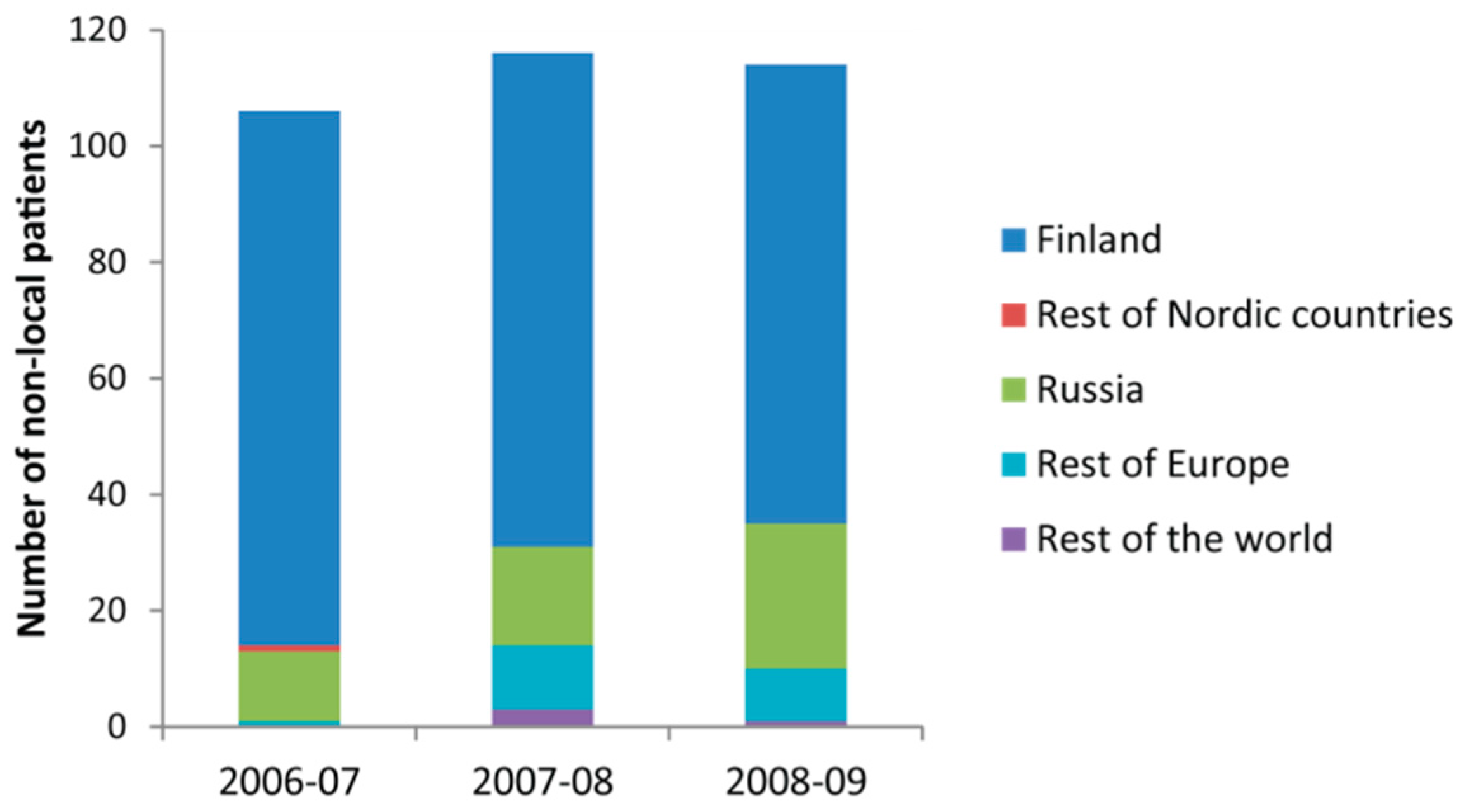

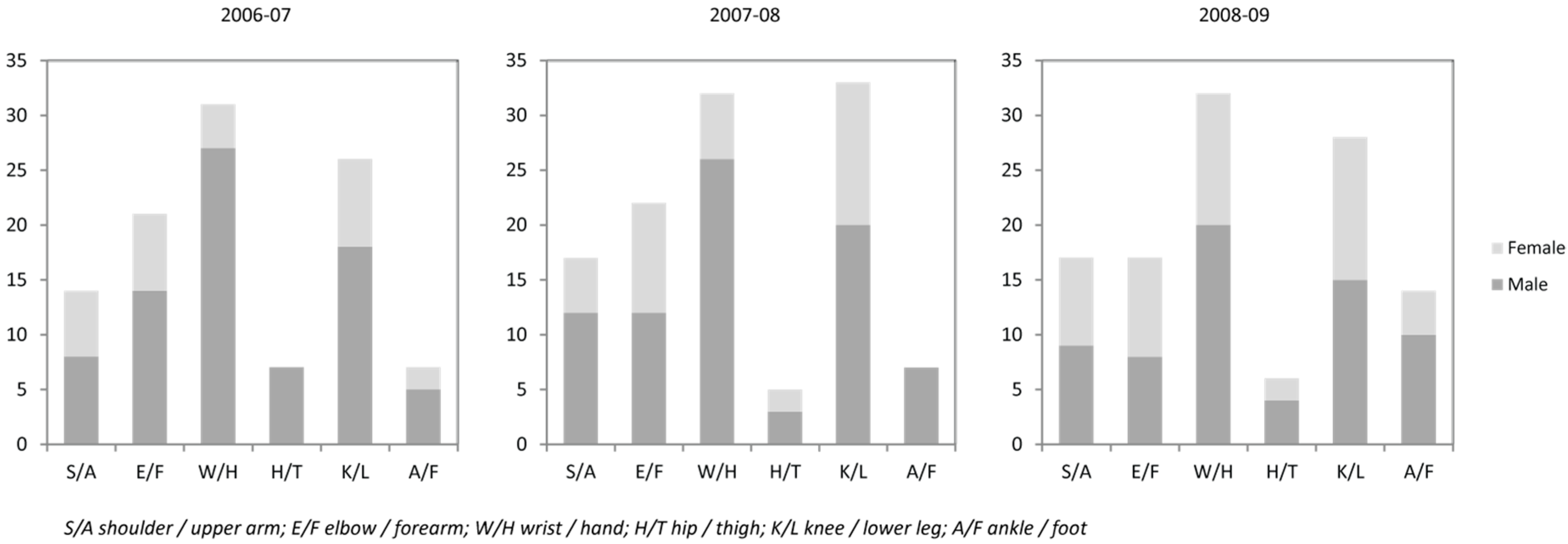
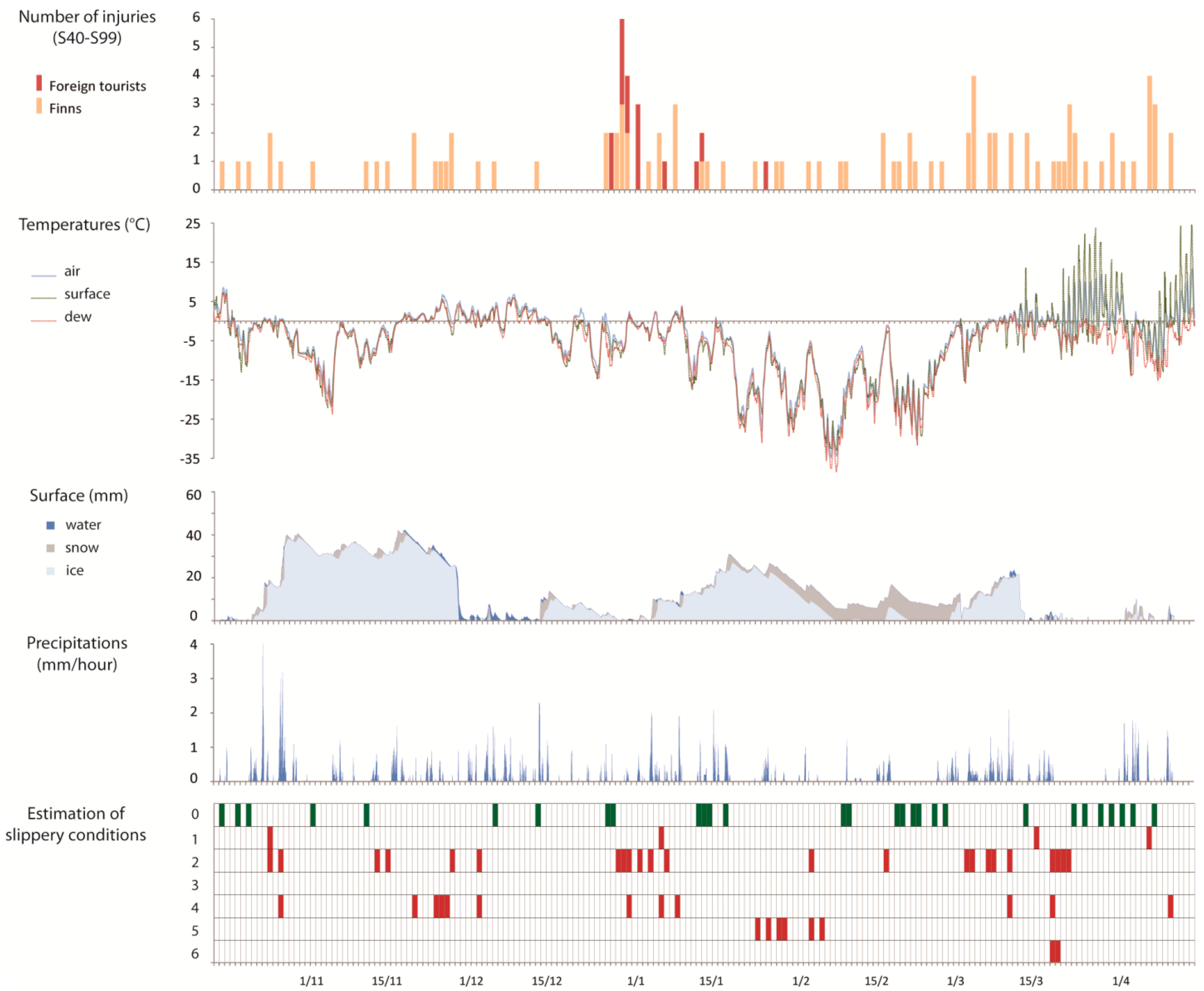
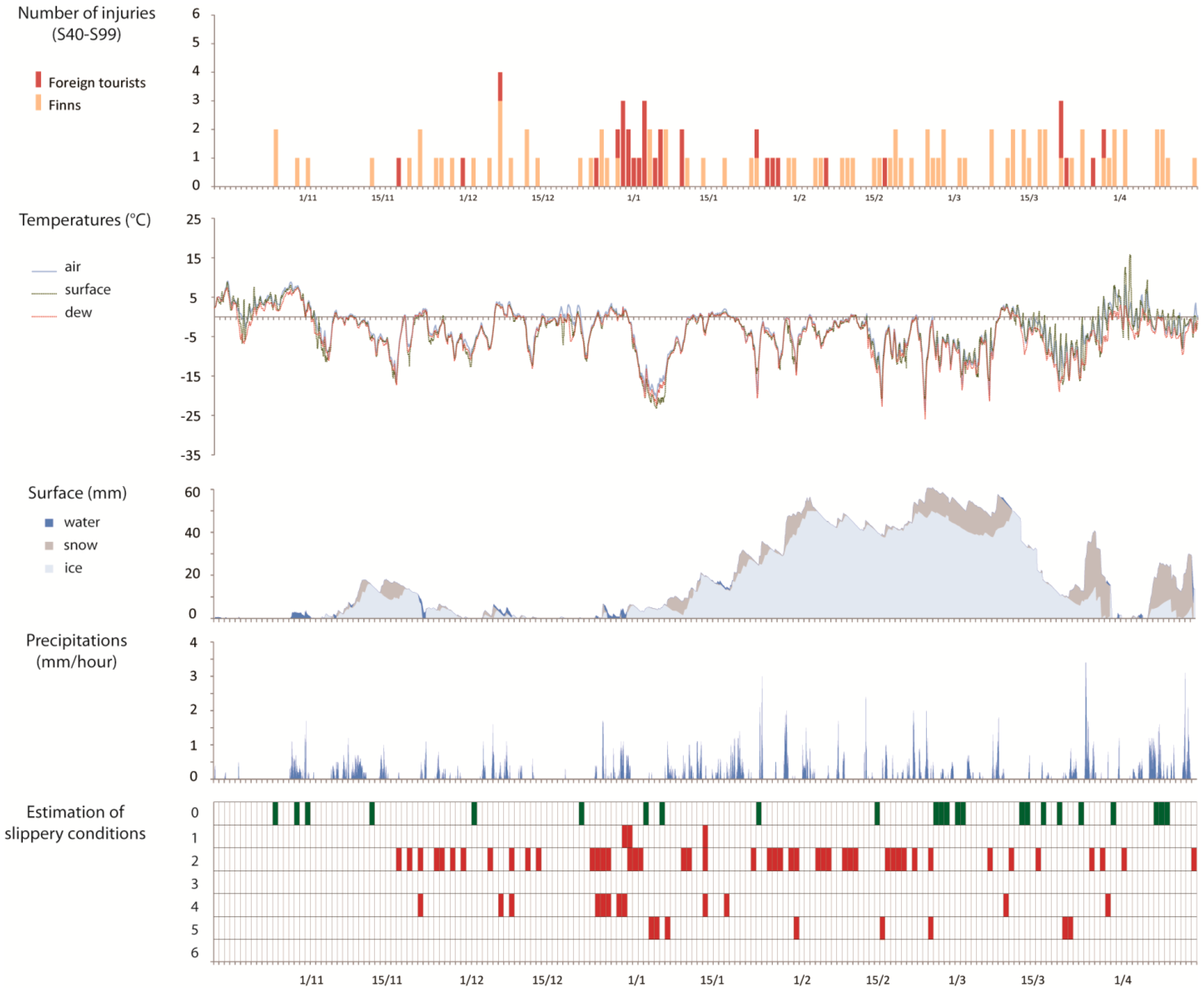
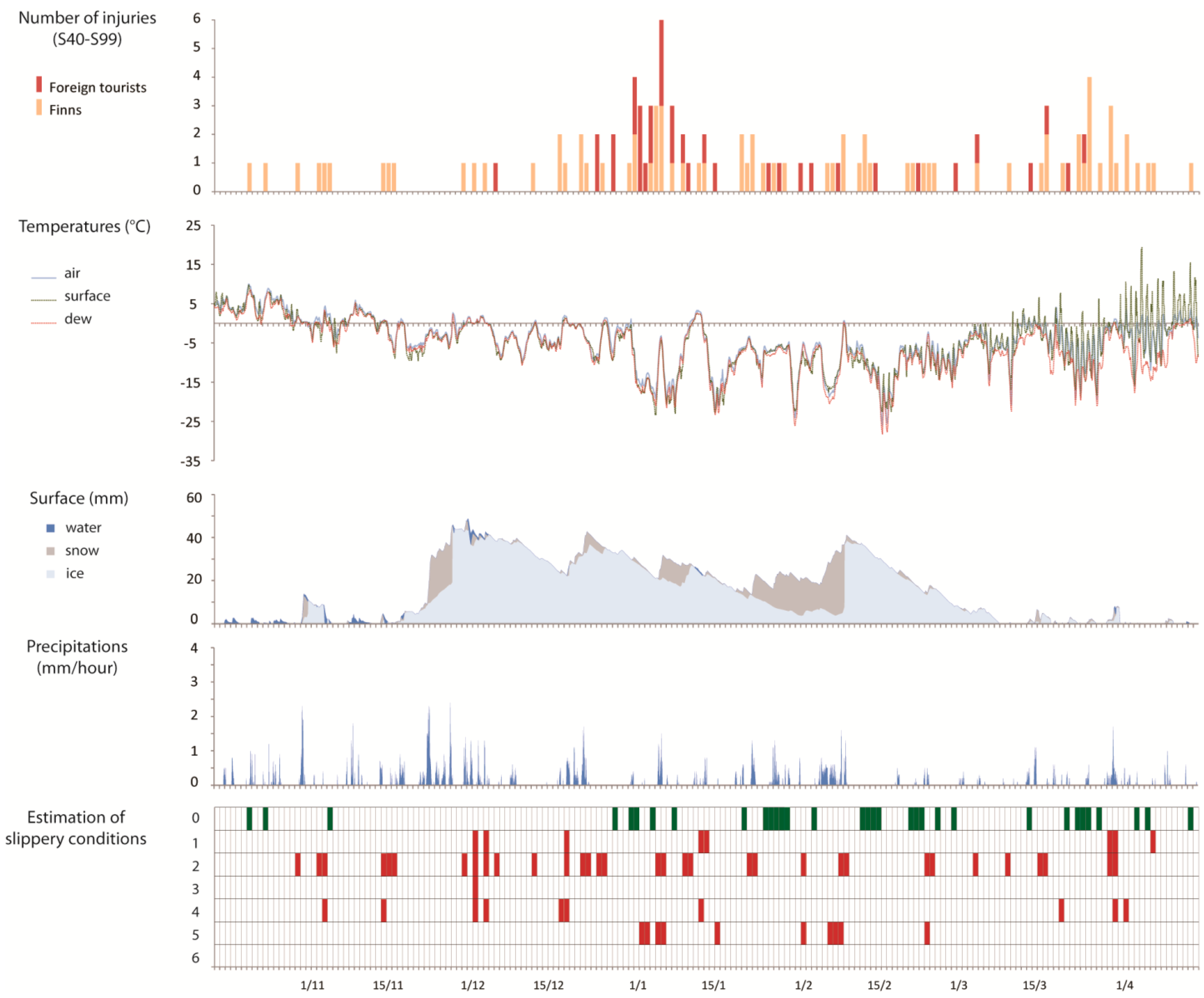
| Scenarios | Slippery Conditions | Weather Variables and the Conditions Causing Slipperiness |
|---|---|---|
| 0 | Not slippery | |
| 1 | Freezing of water surface | |
| This is mainly caused by a decrease of the surface and air temperatures before evaporation. It has the consequence of freezing the water on top of the surface. The ice layer is thin and transparent. | TAmb < 0, Tmp < 0 and SrfWat > 0 (The quantity of water on the surface is taken at the same hour and one hour before) | |
| 2 | Solid condensation | |
| This appears when the water vapour is condensing and when the surface temperature is lower than the dew point (surface temperature has to be below freezing). If the dew point is under 0 °C, there is no liquid phase but the condensation directly changes from water vapour into solid ice crystals. On the other hand, if the dew point temperature is above freezing, then there is a liquid phase of condensation and the water freezes when the temperature drops under 0 °C. | Rhz > 95, Tmp < 0 and Tmp < Tdew (In this case, we consider that the amount of water vapour will be high enough if the relative humidity is greater than 95%) | |
| 3 | Precipitation of freezing fog | |
| This can cause the formation of black ice in the autumn. It happens when the air temperature is below freezing and lower than the dew point and if the surface temperature is also below zero degrees. | TAmb < 0, TAmb < TDew and Tmp < 0 | |
| 4 | Rain on icy surface | |
| “The surface will become very slippery when rain intensity is weak or the amount of precipitation is not very high. Heavy rain melts and makes the ice soft rapidly and no slippery surface can prevail” [12]. | 0 < Prec < 4, SrfWat+1 > 0, SrfSnow = 0 or SrfSnow+1 < SrfSnow and SrfIce > 0 (Here, we consider light rain to be the case when precipitation is under 4 mm/h, as recommended by many meteorologists. Moreover, since the nature of the precipitation is unknown, we considered this to be the case when the surface is covered by water one hour later (+1) and when the snow cover is absent or decreasing) | |
| 5 | Snowfall on an icy surface | |
| “It causes slipperiness when snow is dry enough. This occurs when air temperature is many degrees below zero. Snowfall can be very weak but still cause hazardous conditions. This case is actually worse than the (previous) case with water and ice. A snow covered surface may cause a surprise to pedestrians because it does not look slippery as an icy and wet surface does. When temperature increases above zero the snow starts to melt and friction” decreases [12]. | TAmb < −10, Prec > 0 and SrfIce > 0 | |
| 6 | Supercooled rain, formation of black ice | |
| This happens when rain is falling even although the air temperature is below freezing; black ice will be formed when the water comes into contact with a cold surface. | Prec > 0, Tmp < 0, SrfWat = 0, SrfSnow = 0 and SrfIce-1 = 0 (In this case, we assume that the ground is dry, so the surface is not covered) |
| Study Period | Number of S40–S99 Cases | Finns (%) | Foreigners (%) | Extremity Injuries/All Visits |
|---|---|---|---|---|
| October 2006–April 2007 | 106 | 86.79 | 13.21 | 22.13 |
| October 2007–April 2008 | 116 | 73.25 | 26.75 | 21.13 |
| October 2008–April 2009 | 114 | 69.30 | 30.70 | 20.07 |
| Slippery Condition Scenarios | 2006/2007 | 2007/2008 | 2008/2009 |
|---|---|---|---|
| 0 | 35.8 | 32.8 | 42.1 |
| 1 | 8.5 | 5.2 | 9.6 |
| 2 | 43.4 | 50.0 | 43.9 |
| 3 | 0 | 0 | 0.9 |
| 4 | 19.8 | 17.2 | 10.5 |
| 5 | 5.7 | 9.5 | 16.7 |
| 6 | 1.9 | 0 | 0 |
© 2016 by the authors; licensee MDPI, Basel, Switzerland. This article is an open access article distributed under the terms and conditions of the Creative Commons Attribution (CC-BY) license (http://creativecommons.org/licenses/by/4.0/).
Share and Cite
Lépy, É.; Rantala, S.; Huusko, A.; Nieminen, P.; Hippi, M.; Rautio, A. Role of Winter Weather Conditions and Slipperiness on Tourists’ Accidents in Finland. Int. J. Environ. Res. Public Health 2016, 13, 822. https://doi.org/10.3390/ijerph13080822
Lépy É, Rantala S, Huusko A, Nieminen P, Hippi M, Rautio A. Role of Winter Weather Conditions and Slipperiness on Tourists’ Accidents in Finland. International Journal of Environmental Research and Public Health. 2016; 13(8):822. https://doi.org/10.3390/ijerph13080822
Chicago/Turabian StyleLépy, Élise, Sinikka Rantala, Antti Huusko, Pentti Nieminen, Marjo Hippi, and Arja Rautio. 2016. "Role of Winter Weather Conditions and Slipperiness on Tourists’ Accidents in Finland" International Journal of Environmental Research and Public Health 13, no. 8: 822. https://doi.org/10.3390/ijerph13080822









